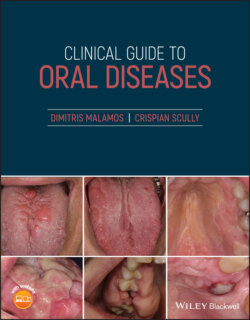Читать книгу Clinical Guide to Oral Diseases - Crispian Scully - Страница 29
Case 2.4
ОглавлениеFigure 2.4
CO: A 72‐year‐old man presented complaining of a black coating on the dorsum of his tongue.
HPC: His black tongue appeared after one week of wide spectrum antibiotic uptake for an upper respiratory infection. This black discoloration appeared suddenly and became daily more dense during treatment. It was associated with mild xerostomia caused by his mouth breathing, and with metallic taste.
PMH: He was suffering from chronic sinusitis, mild hypertension and prostate hypertrophy that were controlled with antibiotics, irbesartan, and tamsulosin tablets respectively. He was an ex‐smoker (stopped smoking eight years ago) and non‐drinker, but used strong mouthwashes on a daily basis.
OE: On examination, black hairy projections on the middle and posterior third of the dorsum of his tongue were seen, but the tip and lateral margins were clear (Figure 2.4). No other lesions were found within his mouth apart from cervical lymphadenopathy which was attributed to his previous upper respiratory infection. The black discoloration was not completely removed by scrubbing with a spatula.
Q1 Which is the possible diagnosis?
1 Hairy black tongue
2 Hairy oral leukoplakia
3 Tongue staining from colored foods
4 Racial pigmentation of tongue
5 Metal poisoning
Answers:
1 Black hairy tongue or lingua villosa nigra is a rare benign tongue condition characterized by elongation of filiform papillae where chromogenic bacteria grow. Poor oral hygiene, black stains from smoking, alcohol, or foods, hyposalivation and antibiotic intake capable to grow for anaerobic chromohenic bacteria or even excessive use of chlorhexidine mouth washes daily are among the possible causes for this condition.
2 No
3 No
4 No
5 No
Comments: Other conditions such as hairy leukoplakia, racial discoloration or that caused by colored foods or metal intake are easily excluded from the black hairy tongue case due to their differences in clinical characteristics such as the color and location, presence of similar or no lesions in the mouth, persistence with scrubbing as well as the patient's history of drug intake or habits. Therefore, in hairy leukoplakia, the lesions are white and usually located on the lateral margins of the tongue, while in racial pigmentation the lesions are located all over the mouth. The dark discoloration caused by colored foods is easily removed with scrubbing, while it remains fixed in metal poisoning and associated with general toxicity symptoms.
Q2 In which other tissues or organs, apart from the tongue, can chromogenic bacteria cause discoloration?
1 Bones
2 Teeth
3 Sclera
4 Skin
5 Heart
Answers:
1 No
2 Chromogenic bacteria in the mouth are responsible for the dark black linear stain that is seen on the cervical part of all teeth (deciduous and permanent) following the contour of gingivae. This stain comes from the deposition of insoluble ferric salts that are produced from the interaction of hydrogen sulfide released from chromogenic bacteria with iron, which is found in the saliva or gingival exudate.
3 No
4 No
5 No
Comments: Discoloration of bones and soft tissues of the skin, heart, and sclera of the eyes are caused by a number of local and systemic causes including trauma, metabolic diseases, tumors (de novo or metastatic) and metals or drugs such as minocycline deposition.
Q3 Which of the bacteria below is the most predominant in dark teeth stains?
Porphyromonas gingivalis
Prevotella melaninogenica
Actinomyces
Fusobacterium nucleatum
Mycobacterium lepromatosis
Answers:
1 No
2 No
3 Actinomyces species are predominant in saliva of patients with black stains on their teeth.
4 No
5 No
Comments: Other bacteria like Porphyromonas gingivalis and Fusobacterium nucleatum are implicated in various periodontal diseases while Prevotella melaninogenica and Mycobacterium lepromatosis cause anaerobic infections of the upper respiratory tract and leprosy respectively.
